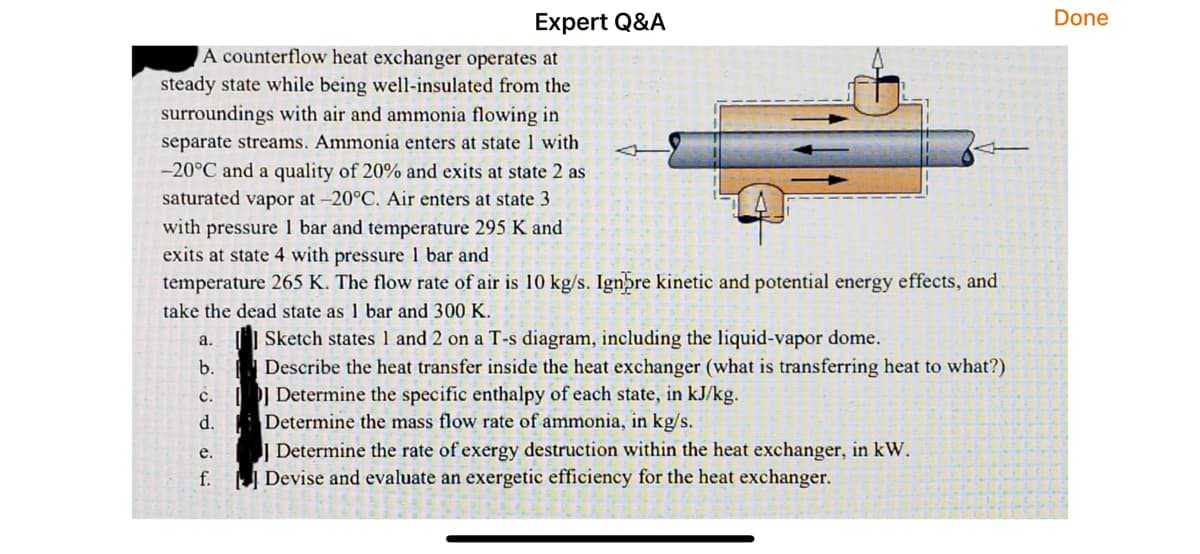Expert Q&A A counterflow heat exchanger operates at steady state while being well-insulated from the surroundings with air and ammonia flowing in separate streams. Ammonia enters at state 1 with -20°C and a quality of 20% and exits at state 2 as saturated vapor at -20°C. Air enters at state 3 with pressure 1 bar and temperature 295 K and exits at state 4 with pressure 1 bar and temperature 265 K. The flow rate of air is 10 kg/s. Ignore kinetic and potential energy effects, and take the dead state as 1 bar and 300 K. a. Sketch states 1 and 2 on a T-s diagram, including the liquid-vapor dome. b. Describe the heat transfer inside the heat exchanger (what is transferring heat to what?) Determine the specific enthalpy of each state, in kJ/kg. d. Determine the mass flow rate of ammonia, in kg/s. Determine the rate of exergy destruction within the heat exchanger, in kW. f. Devise and evaluate an exergetic efficiency for the heat exchanger.
Expert Q&A A counterflow heat exchanger operates at steady state while being well-insulated from the surroundings with air and ammonia flowing in separate streams. Ammonia enters at state 1 with -20°C and a quality of 20% and exits at state 2 as saturated vapor at -20°C. Air enters at state 3 with pressure 1 bar and temperature 295 K and exits at state 4 with pressure 1 bar and temperature 265 K. The flow rate of air is 10 kg/s. Ignore kinetic and potential energy effects, and take the dead state as 1 bar and 300 K. a. Sketch states 1 and 2 on a T-s diagram, including the liquid-vapor dome. b. Describe the heat transfer inside the heat exchanger (what is transferring heat to what?) Determine the specific enthalpy of each state, in kJ/kg. d. Determine the mass flow rate of ammonia, in kg/s. Determine the rate of exergy destruction within the heat exchanger, in kW. f. Devise and evaluate an exergetic efficiency for the heat exchanger.
Principles of Heat Transfer (Activate Learning with these NEW titles from Engineering!)
8th Edition
ISBN:9781305387102
Author:Kreith, Frank; Manglik, Raj M.
Publisher:Kreith, Frank; Manglik, Raj M.
Chapter7: Forced Convection Inside Tubes And Ducts
Section: Chapter Questions
Problem 7.49P
Related questions
Concept explainers
Heat Exchangers
Heat exchangers are the types of equipment that are primarily employed to transfer the thermal energy from one fluid to another, provided that one of the fluids should be at a higher thermal energy content than the other fluid.
Heat Exchanger
The heat exchanger is a combination of two words ''Heat'' and ''Exchanger''. It is a mechanical device that is used to exchange heat energy between two fluids.
Question

Transcribed Image Text:Expert Q&A
A counterflow heat exchanger operates at
steady state while being well-insulated from the
surroundings with air and ammonia flowing in
separate streams. Ammonia enters at state 1 with
-20°C and a quality of 20% and exits at state 2 as
saturated vapor at -20°C. Air enters at state 3
with pressure 1 bar and temperature 295 K and
exits at state 4 with pressure 1 bar and
temperature 265 K. The flow rate of air is 10 kg/s. Ignore kinetic and potential energy effects, and
take the dead state as 1 bar and 300 K.
a.
Sketch states 1 and 2 on a T-s diagram, including the liquid-vapor dome.
b.
Describe the heat transfer inside the heat exchanger (what is transferring heat to what?)
c.
Determine the specific enthalpy of each state, in kJ/kg.
d.
Determine the mass flow rate of ammonia, in kg/s.
e.
Determine the rate of exergy destruction within the heat exchanger, in kW.
f.
Devise and evaluate an exergetic efficiency for the heat exchanger.
Done
Expert Solution
This question has been solved!
Explore an expertly crafted, step-by-step solution for a thorough understanding of key concepts.
This is a popular solution!
Trending now
This is a popular solution!
Step by step
Solved in 2 steps with 2 images

Knowledge Booster
Learn more about
Need a deep-dive on the concept behind this application? Look no further. Learn more about this topic, mechanical-engineering and related others by exploring similar questions and additional content below.Recommended textbooks for you

Principles of Heat Transfer (Activate Learning wi…
Mechanical Engineering
ISBN:
9781305387102
Author:
Kreith, Frank; Manglik, Raj M.
Publisher:
Cengage Learning

Principles of Heat Transfer (Activate Learning wi…
Mechanical Engineering
ISBN:
9781305387102
Author:
Kreith, Frank; Manglik, Raj M.
Publisher:
Cengage Learning